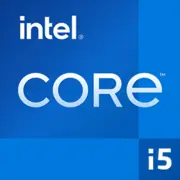Intel Core i5-11300H

Intel Core i5-11300H: A Versatile Processor for Mobile Tasks
April 2025
The Intel Core i5-11300H processor, introduced in 2021, remains a popular choice for ultrabooks and compact laptops due to its balance of performance, energy efficiency, and affordability. Let's discuss who this chip is suitable for in 2025 and what tasks it can tackle.
1. Architecture and Process Technology: Tiger Lake and 10nm SuperFin
Cores, Threads, and Frequencies
The Core i5-11300H is built on the Tiger Lake architecture, utilizing the 10nm SuperFin process technology. This has allowed Intel to enhance energy efficiency and increase clock speeds. The processor features:
- 4 cores and 8 threads thanks to Hyper-Threading;
- Base frequency of 3.1 GHz and maximum turbo frequency up to 4.4 GHz;
- 8 MB of L3 cache, which accelerates data processing in multitasking scenarios.
Integrated Graphics Intel Iris Xe
The built-in Iris Xe GPU (80 EU) is a key advantage of the chip. It supports:
- 4K displays at 60 Hz;
- HDMI 2.0 and DisplayPort 1.4 technologies;
- Hardware acceleration for video encoding/decoding (AV1, VP9, H.265).
For gaming, Iris Xe is somewhat limited: in Dota 2 or CS:GO at medium settings (1080p), you can achieve 40-60 FPS, but modern AAA titles will require a discrete graphics card.
2. TDP 28W: Power Consumption and Thermal Management
The nominal TDP of the processor is 28W, but in reality, it dynamically changes from 15W (in power-saving mode) to 35W under load. This makes it flexible for different types of devices:
- Ultrabooks (e.g., ASUS ZenBook 14) use lower TDP to extend battery life;
- Compact work laptops (Dell XPS 13) configure a higher TDP for stable performance.
Cooling systems in such devices usually feature one or two fans, but even under prolonged load, temperatures rarely exceed 85°C.
3. Performance in Real-World Tasks
Office and Multimedia
- Office applications: In Microsoft Office, a browser with 20+ tabs, and Zoom, the processor operates smoothly without lag.
- Video editing: Rendering a 1080p video in Adobe Premiere Pro will take about 8-10 minutes (compared to 5-7 minutes with Apple M1).
- Photo editors: Photoshop and Lightroom process RAW files quickly, but applying complex filters may cause brief stutters.
Gaming
- Casual games: Overwatch 2 at low settings (1080p) — 50-60 FPS;
- Emulators: Nintendo Switch (Yuzu) — 30-40 FPS in non-demanding projects;
- Cloud gaming (GeForce Now/Xbox Cloud) — an optimal option for modern games.
Turbo Mode
Under brief loads (e.g., opening a heavy Excel file), the frequency rises to 4.4 GHz, but after 15-20 seconds, it drops back to 3.8-4.0 GHz due to heat. For prolonged tasks (rendering), the stable frequency is around 3.5 GHz.
4. Usage Scenarios: Who is the i5-11300H Suitable For?
- Students and office workers: For studying, document processing, and video conferencing.
- Beginner creatives: Photo processing, editing short videos.
- Mobile gamers: Only for lighter games or cloud gaming.
- Users valuing portability: Laptops weighing 1.2-1.5 kg with a 13-14 inch display.
Example device: Lenovo Yoga 7i (price in 2025 — $600-700) with a 14" 2.8K screen, 16 GB RAM, and 512 GB SSD.
5. Battery Life: How Long Does the Laptop Last?
With a battery capacity of 50-60 Wh, the battery life is:
- 8-10 hours for web surfing and text work (brightness 50%);
- 4-5 hours for video editing or using Zoom;
- 2-3 hours in gaming.
Power-saving technologies:
- Intel Dynamic Tuning automatically reduces TDP when unplugged;
- Adaptix optimizes core load;
- "Power Saver" mode in Windows reduces frequency to 2.0 GHz.
6. Comparison with Competitors
AMD Ryzen 5 5600U
- Pros: 6 cores/12 threads, better for multi-threaded tasks (rendering, code compilation).
- Cons: Weaker in single-threaded tests (Geekbench 6 Single Core — 1450), integrated Vega 7 graphics lag behind Iris Xe.
Apple M1
- Pros: Better energy efficiency (18-20 hours battery life), high performance in "native" applications.
- Cons: Limited compatibility with Windows software.
Intel Core i5-1235U (12th generation)
- Pros: Higher performance (Geekbench 6 Multi Core — 6200), supports DDR5.
- Cons: Laptops with this chip cost $200-300 more.
7. Pros and Cons of i5-11300H
Strengths:
- High single-threaded performance;
- Powerful integrated graphics with Iris Xe;
- Support for Thunderbolt 4 and Wi-Fi 6;
- Affordable laptop prices ($600-800).
Weaknesses:
- Only 4 cores — inadequate for rendering or 3D modeling;
- Heating under load;
- Lags behind newer processors from 2024-2025 in multi-threading.
8. Recommendations for Laptop Selection
- Type of device: Ultrabook or hybrid 2-in-1 (e.g., HP Spectre x360).
- RAM: At least 16 GB for multitasking.
- Storage: SSD 512 GB (PCIe 3.0 or 4.0).
- Display: IPS panel with at least Full HD resolution.
- Ports: Presence of Thunderbolt 4 for connecting an external GPU or monitor.
Important: Check the cooling system. Devices with dual fans (e.g., ASUS Vivobook Pro 14) are quieter under load.
9. Final Conclusion
The Intel Core i5-11300H in 2025 is a solid choice for those seeking an affordable ($600-800) laptop for everyday tasks. It is suitable for:
- Users who prioritize mobility and battery life;
- Those working with office applications and lightweight creative software;
- Gamers willing to play on cloud services or at low settings.
Alternatives: If the budget allows, consider laptops with Intel Core i5-1240P or AMD Ryzen 7 7730U — they offer more cores and better hardware for $900-1000.
Basic
CPU Specifications
Memory Specifications
GPU Specifications
Miscellaneous
Benchmarks
Compared to Other CPU
Share in social media
Or Link To Us
<a href="https://cputronic.com/en/cpu/intel-core-i5-11300h" target="_blank">Intel Core i5-11300H</a>